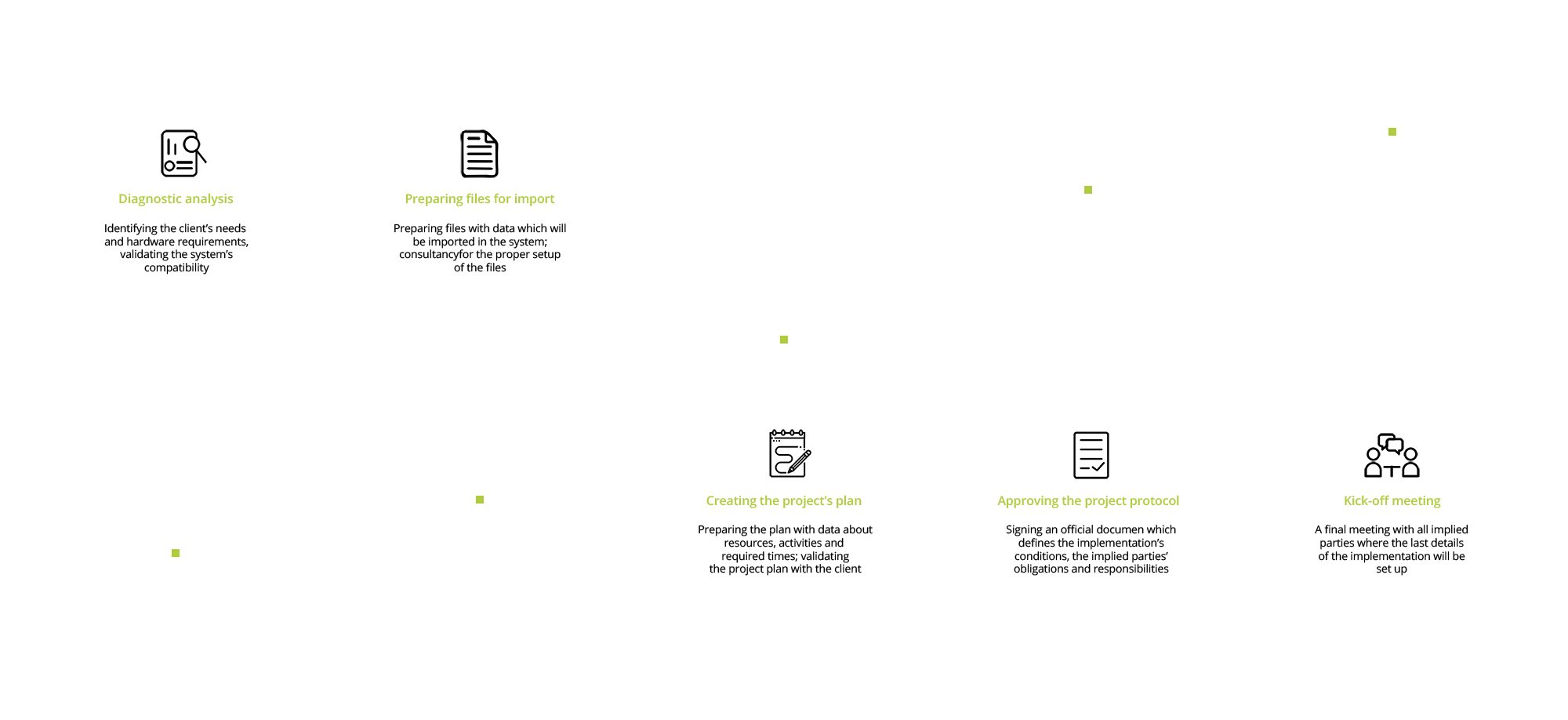analysis

The first steap towards your company’s digitization
ERP analysis, or the analysis of the company’s business processes, is done before the project implementation, being a proactive operation which lowers risk factors and sets realistic goals.
The detailed business analysis is vital in the company digitization project’s success, future development perspectives being determined at this stage.
The ERP analysis process means:
Defining existing flows
Knowing and setting activity and document flows specific to the company
Company data analysis
Detailing actual data and integration necessities with other systems used within the company
Defining future work procedures
Creating a strategy by making decisions regarding the optimization of current operations
Setting implementation coordinates
Identifying necessary customizations, so that the company’s will function within optimal parameters.
What are the advantages of the ERP analysis process?
Understanding the client's needs
Brings us closer to the client and helps us understand how the business works
Project customization
Set the way in which the ERP system molds to your organization’s specific activities
Remodeling the company's processes
Propose solutions for optimal resource management, so that the implementation is a success

Clearly defined strategies
Set preliminary goals for the implementation process for the resource management system
The project's perspective
It gives the client a clear view over the benefits of implementing an ERP
Judging the required investment
Gives a complete, detailed explanation of the costs required for an ERP implementation
“Senior Software, with whom we started collaborating 10 years ago, proved that it is the ideal partner for distribution companies, because special attention is paid to identifying the right correlations for business activities efficiency.”
Eugen Savu – CEO Parmafood
Information followed during the ERP analysis process
Other software used
The newly implemented sistem’s interaction with the other systems and the definition of interfacing needs
Company organization
Departmental structure, user roles, country-wide hierarchy
Work flows
Activities specific to each department, relationships between departments, internal approval flows, document circuits
Data volume
Preparing data imports from currently used systems or files
Existing hardware infrastructure
Defining technical specifications in order to correctly dimension the app
Defining security rules
Setting the company’s internal protocols in detail
Alte sisteme software utilizate
Interactiunea noului sistem implementat cu celelalte sisteme si definirea nevoilor de interfatare
Organizarea companiei
Structura departamentala, rolurile utilizatorilor, ierarhia din cadrul companiei
Fluxurile de lucru
Activitatile specifice fiecarui department, relationarea dintre departamente, fluxurile de aprobare interne, circuitul documentelor
Volumul de date
Pregatirea importurilor de date din sistemele sau fisierele actuale
Infrastructura hardware existenta
Definirea specificatiilor tehnice in vederea dimensionarii corecte a aplicatiei
Definirea regulilor de securitate
Stabilirea in detaliu a protocoalelor interne ale companiei
Digitalizarea afacerii tale
The success of any digitization project greatly depends on the quality of the analysis processes within the company and the implementation consultant’s experience.
Company processes analysis steps
Diagnostic analysis
The purpose of this step is identifying the clients’ requests and to verify the solution’s compatibility with the company’s activity. Here, the consultant will give the client information relating to the requested installation method and will make recommendations regarding the related hardware and software necessities.
Preparing files for import
The success of the implementation is directly influenced by how much the client is implied and by the way he really understands how the ERP system will help. Thus, it is very important that the examples given by the SeniorERP consultants are made using the client’s data.
In order for this to be done, the client must prepare in advance all files with the data that will be imported into the ERP system. Thus, when the implementation process starts, the system will contain the client’s data, instead of a test database.
Pregatirea fisierelor de import
Conform experientei specialistilor nostri, succesul implementarii este direct influentat de implicarea clientului si de modul in care acesta intelege concret cum il va ajuta sistemul ERP. De aceea, este extrem de important ca exemplificarile realizate de consultantii SeniorERP sa fie facute pe datele clientului. Pentru ca acest lucru sa poata fi realizat, clientul trebuie sa pregateasca din timp toate fisierele cu datele care urmeaza sa fie importate in sistemul ERP: articole, parteneri, solduri, mijloace fixe, politici comerciale si nu numai. Astfel, in momentul demararii procesului de implementare, in sistem vor fi datele clientului, in locul unei baze de date de test. Sesiunile de instruire vor fi realizate cu informatii care le sunt familiare utilizatorilor, iar ei vor putea asimila si intelege mai bine fluxurile si modalitatile de lucru.

Creating the project plan
The SeniorERP consultant team creates the project plan in close collaboration with the project’s beneficiary. This will include all details that were set up in advance with the client in regards to required resources, activities that will be done and the required time.
Approving the implementation protocol
It is an official document that defines the conditions in which the implementation will take place, the obligations and responsibilities of the parts, so that goals will be reached.
Kick-off meeting
It is an final meeting where all peoeple implied in the project participate, from both the clients’ and Senior Software’s sides. Here all details required for the implementation are discussed.

 Romanian
Romanian English
English






















